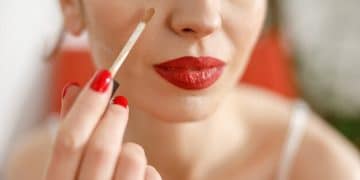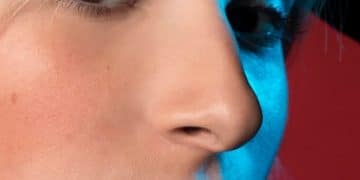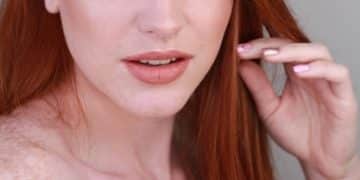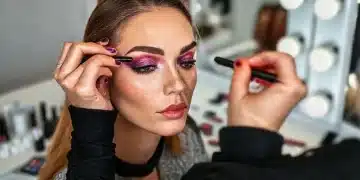How to Choose Makeup Brushes: A Beginner’s Guide
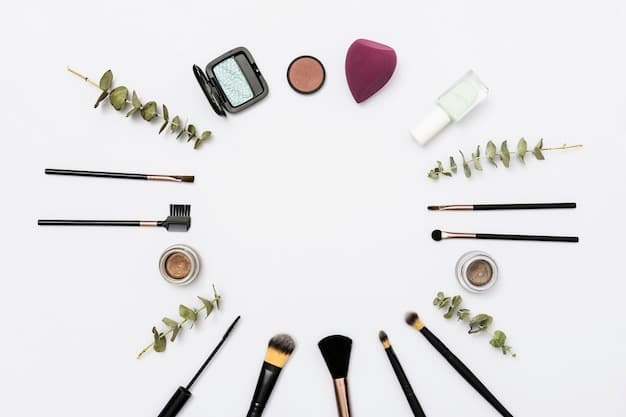
Choosing the right makeup brushes can be overwhelming for beginners, but understanding brush types (face, eye, lip), materials (synthetic, natural), and shapes (flat, rounded, angled) is key to achieving a flawless makeup application.
Navigating the world of makeup brushes can feel like deciphering a secret code, especially for beginners. With so many shapes, sizes, and materials, where do you even start? This guide will break down everything you need to know about how to choose the right makeup brushes, helping you achieve a flawless look with confidence.
Understanding the Basics of Makeup Brushes
Before diving into the specific types of brushes, it’s helpful to understand the fundamental components that make up a makeup brush. These include the bristles, the ferrule, and the handle. Each part plays a role in the brush’s performance and overall quality.
Getting to grips with the anatomy of a brush, as well as the difference between natural and synthetic bristles, will make your decision making process easier.
Anatomy of a Makeup Brush
A makeup brush consists of three main parts: the bristles (or brush head), the ferrule, and the handle. The bristles are what you use to apply the makeup, the ferrule connects the bristles to the handle, and the handle provides a grip for control. A well-constructed brush will have a secure ferrule that prevents the bristles from shedding.
The material that the bristles are made from is very important too, as you will find our later.
Natural vs. Synthetic Bristles
Makeup brush bristles come in two main types: natural and synthetic. Natural bristles are typically made from animal hair, such as goat, squirrel, or pony hair. They are known for their softness and ability to pick up and distribute powder products evenly. Synthetic bristles, on the other hand, are made from man-made materials like nylon or taklon. They are more durable, easier to clean, and suitable for applying liquid and cream products. They are also cruelty-free.
Considering what type of look you like to go for, and how important is for you your brushes being easy to clean will also aid you in your decision.
- Natural Bristles: Best for powder products, soft application, and blending.
- Synthetic Bristles: Ideal for liquid and cream products, precise application, and those with allergies.
- Handle Material: Wood handles offer durability, while plastic handles are more lightweight and affordable.
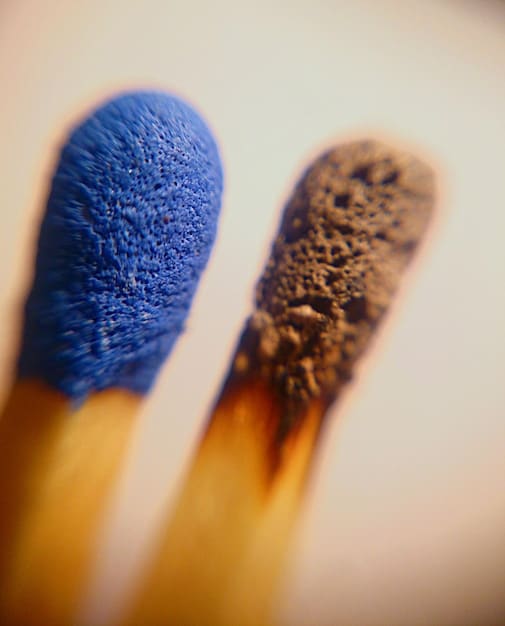
In conclusion, understanding the anatomy and bristle types of makeup brushes is fundamental to making informed decisions. Natural bristles excel with powder products, offering a soft, blended application, while synthetic bristles are best for liquids and creams, providing precision and ease of cleaning. Whether opting for natural or synthetic, each has its unique advantages, so considering your makeup preferences and any sensitivities will ensure you pick the best items for your needs.
Essential Face Brushes for Beginners
When starting your makeup brush collection, focusing on essential face brushes is a great first step. These brushes will help you achieve a flawless base and enhance your natural features, so you can have the perfect base for your makeup.
Having the right brushes can make a huge difference when it comes to applying base, and this makes the process quicker and easier.
Foundation Brush
A foundation brush is essential for applying liquid, cream, or powder foundation evenly. Look for a brush with dense bristles and a flat or slightly rounded shape. This type of brush will help you build coverage and blend the produce seamlessly into the skin.
Not only can it make your makeup look more professional, but it can also help you reduce the ammount of product you are using, therefore making it more economically friendly.
Concealer Brush
A concealer brush is smaller and more precise than a foundation brush. It is designed to apply concealer to specific areas, such as under the eyes or on blemishes. Opt for a small, tapered brush with soft bristles for a seamless finish.
If you use a concealer everyday, or even if you don’t, you will be surprised by the difference this makes when it comes to blending it into your skin, leaving a more natural look.
Powder Brush
A powder brush is large and fluffy, perfect for applying loose or pressed powder to set your foundation. Choose a brush with soft, loosely packed bristles to distribute the product evenly without caking.
- Foundation Brush: Apply liquid or cream foundation evenly for a smooth base.
- Concealer Brush: Target blemishes or under-eye circles for precise coverage.
- Powder Brush: Set foundation with loose or pressed powder for a matte finish.
In summary, the right face brushes are crucial for achieving a flawless base. A foundation brush ensures even application, a concealer brush targets specific areas, and a powder brush sets your makeup for a lasting finish. Selecting high-quality, well-shaped brushes will enhance your makeup routine and boost your confidence.
Indispensable Eye Makeup Brushes
Eye makeup brushes are essential for creating a variety of looks, from simple daytime enhancements to dramatic evening styles. Having a selection of different shapes and sizes will allow you to blend and define your eyes with precision and control.
A good eye makeup brush can make all the difference when it comes to achieving a perfect eye look.
Eyeshadow Brush
An eyeshadow brush is a staple in any makeup collection. It is used to apply eyeshadow to the eyelids. Look for a brush with a rounded or oval shape and soft bristles. This type of brush will allow you to pack on color and blend the edges for a seamless transition.
If you only have space in your kit for one eye brush, this should be the one.
Blending Brush
A blending brush is essential for softening harsh lines and creating a gradient effect on your eyelids. Choose a brush with long, fluffy bristles that taper to a point. This will allow to blend color on the crease making it look naturaly diffused.
This is important if you use many different colors on your eye looks.
Eyeliner Brush
An eyeliner brush is thin and angled, perfect for applying gel or cream eyeliner to the lash line. Choose a brush with firm bristles that won’t fray or splay. This type of brush will allow you to create a precise line and wing out the edges for a cat-eye effect.
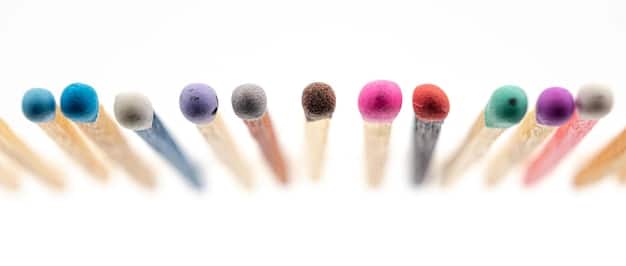
- Eyeshadow Brush: Apply eyeshadow evenly across the eyelid for a wash of color.
- Blending Brush: Soften harsh lines and blend eyeshadows seamlessly.
- Eyeliner Brush: Create precise lines along the lash line with gel or cream eyeliner.
In conclusion, mastering eye makeup starts with the right brushes. An eyeshadow brush provides even color, a blending brush ensures seamless transitions, and an eyeliner brush creates precise lines. Investing in high-quality brushes tailored to these specific tasks will elevate your eye makeup looks, making application easier and results more professional.
Specialty Brushes: Enhancing Your Makeup Routine
Once you’ve mastered the basics, specialty makeup brushes can take your makeup routine to the next level. These brushes are designed for specific purposes and can help you achieve more advanced techniques and effects .
They can seem inaccesible at first, but once you have a bit more knowledge about your own technique, you will grow to love them.
Contour Brush
A contour brush is angled and dense, designed to sculpt and define your facial features. Use it to apply powder or cream contour along the cheekbones, jawline, and temples for a more defined look. Choose a brush with soft bristles that won’t create harsh, unnatural lines.
It is important that it feels right on your skin, as it makes the whole process easier.
Highlight Brush
A highlight brush is tapered and fluffy, used to apply highlighter to the high points of your face, such as the cheekbones, brow bone, and cupid’s bow. Opt for a brush with soft bristles that will pick up and distribute the product evenly for a subtle, luminous glow.
This can really bring your makeup look together and give some extra dimension.
Lip Brush
A lip brush is small and pointed, used to apply lipstick or lip gloss with precision. It can help you create a sharp, defined lip line and fill in the color evenly. Choose a brush with firm bristles that won’t splay or fray.
- Contour Brush: Sculpt and define facial features by applying contour along the cheekbones and jawline.
- Highlight Brush: Add a luminous glow to the high points of your face, such as cheekbones and brow bone.
- Lip Brush: Apply lipstick with precision for a defined and long-lasting lip look.
In summary, specialty brushes elevate your makeup game by enabling advanced techniques. A contour brush sculpts and defines, a highlight brush adds a luminous glow, and a lip brush ensures precise lipstick application. These tools enhance your ability to create polished, professional makeup looks, making your routine more versatile.
Caring for Your Makeup Brushes
Properly caring for your makeup brushes is essential for maintaining hygiene, extending their lifespan, and ensuring optimal performance. Regular cleaning and storage will prevent the buildup of bacteria and product residue, keeping your skin healthy and your brushes in good condition.
If you feel like your makeup has not been applying that well recently, consider cleaning your brushes as it is a comon problem that is easily solved.
Cleaning Your Brushes
Clean your makeup brushes regularly to remove bacteria, dirt, and product residue. Wash your brushes every one to two weeks, depending on how often you use them. Use a gentle brush cleanser or mild shampoo and warm water to clean the bristles. Rinse thoroughly and squeeze out any excess water. Lay the brushes flat to dry or use a brush drying rack.
If you have sensitive skin, remember to patch test whatever product you use to wash them before using the clean brushes on your face.
Storing Your Brushes
Store your makeup brushes properly to protect the bristles from damage and prevent the buildup of dust and debris. Keep your brushes in a brush holder or case, away from direct sunlight and moisture. Avoid storing brushes in a drawer or bag where they can become bent or crushed.
If you don’t have any specific storage, there are plenty of affordable options online that you can try.
Extending the Lifespan of Your Brushes
Handle your makeup brushes with care to prevent damage and extend their lifespan. Avoid pressing too hard when applying makeup, as this can cause the bristles to fray or break. Do not soak the entire brush in water, as this can loosen the glue that holds the bristles in place. Replace your brushes every one to two years, or when the bristles start to fray or lose their shape.
- Cleaning: Wash brushes every 1-2 weeks to prevent bacteria buildup.
- Storage: Store brushes in a holder or case to protect the bristles.
- Lifespan: Replace brushes every 1-2 years, or when bristles fray.
In conclusion, caring for your makeup brushes is crucial for hygiene and performance. Regular cleaning prevents bacteria buildup, proper storage protects the bristles, and gentle handling extends their lifespan. Investing a little time in brush maintenance ensures that your tools remain effective, safe, and long-lasting.
Decoding Brush Shapes and Their Uses
Understanding the different shapes of makeup brushes and their intended uses can significantly improve your makeup application technique. Each shape is designed to perform a specific task, whether it’s applying foundation, blending eyeshadow, or defining the lips. Knowing which brush to use for each step will help you achieve a more polished and professional finish.
Even seemingly very similar brushes can lead you to a different result.
Flat Brushes
Flat brushes have a flat, even surface and are ideal for applying products to large areas of the face or eyelids. Use a flat foundation brush to apply liquid or cream foundation evenly, or a flat shader brush to pack color onto the eyelids. These brushes provide full coverage and precise application.
Their structure makes them easy to control.
Rounded Brushes
Rounded brushes have a dome-shaped head and soft, fluffy bristles. They are perfect for blending and diffusing products, such as eyeshadow or blush. Use a rounded blending brush to soften harsh lines on the eyelids, or a rounded blush brush to apply blush to the apples of your cheeks. These brushes create a natural, diffused finish.
Perfect if you are a fan of soft glam.
Angled Brushes
Angled brushes have a slanted shape and firm bristles. They are designed for precise application and defining features, such as the eyebrows or eyeliner. Use an angled brow brush to fill in sparse areas of your eyebrows, or an angled eyeliner brush to create a sharp, defined line along the lash line. These brushes provide control and precision.
- Flat Brushes: Apply foundation or eyeshadow for full coverage and precise placement.
- Rounded Brushes: Blend and diffuse products like eyeshadow and blush for a soft finish.
- Angled Brushes: Define eyebrows and create sharp eyeliner lines with precision.
In conclusion, understanding brush shapes and their uses enhances your makeup technique. Flat brushes offer full coverage, rounded brushes ensure seamless blending, and angled brushes provide precise definition. Selecting the right shape for each step of your routine will result in a more refined and professional makeup look.
| Key Point | Brief Description |
|---|---|
| ✨ Brush Types | Face, eye, and specialty brushes each serve unique makeup application needs. |
| 🌿 Bristle Material | Natural bristles excel with powders, while synthetic handles liquids and creams best. |
| 📐 Brush Shapes | Flat, rounded, and angled brushes each offer unique uses for application and blending. |
| 🧼 Cleaning & Care | Regular cleaning and correct storage enhance brush longevity and hygiene. |
Frequently Asked Questions
▼
It’s recommended to clean your makeup brushes every one to two weeks to prevent bacteria buildup and ensure smooth application.
▼
Natural bristles are best for powder application, while synthetic bristles work well with liquid and cream products, offering durability and easy cleaning.
▼
Store your brushes in a brush holder or case to protect the bristles and prevent dust accumulation, ensuring they maintain their shape.
▼
Essential brushes include a foundation brush, concealer brush, powder brush, eyeshadow brush, and blending brush for a complete basic makeup application.
▼
While possible, it’s best to use separate brushes for different products to prevent color mixing and ensure the best application. Clean the brush in between.
Conclusion
Choosing the right makeup brushes can make a significant difference in your makeup routine. By understanding the different types of brushes, their shapes, and materials, you can create a flawless, professional look with ease. Remember to care for your brushes properly to extend their lifespan and maintain hygiene, ensuring your makeup always looks its best.
